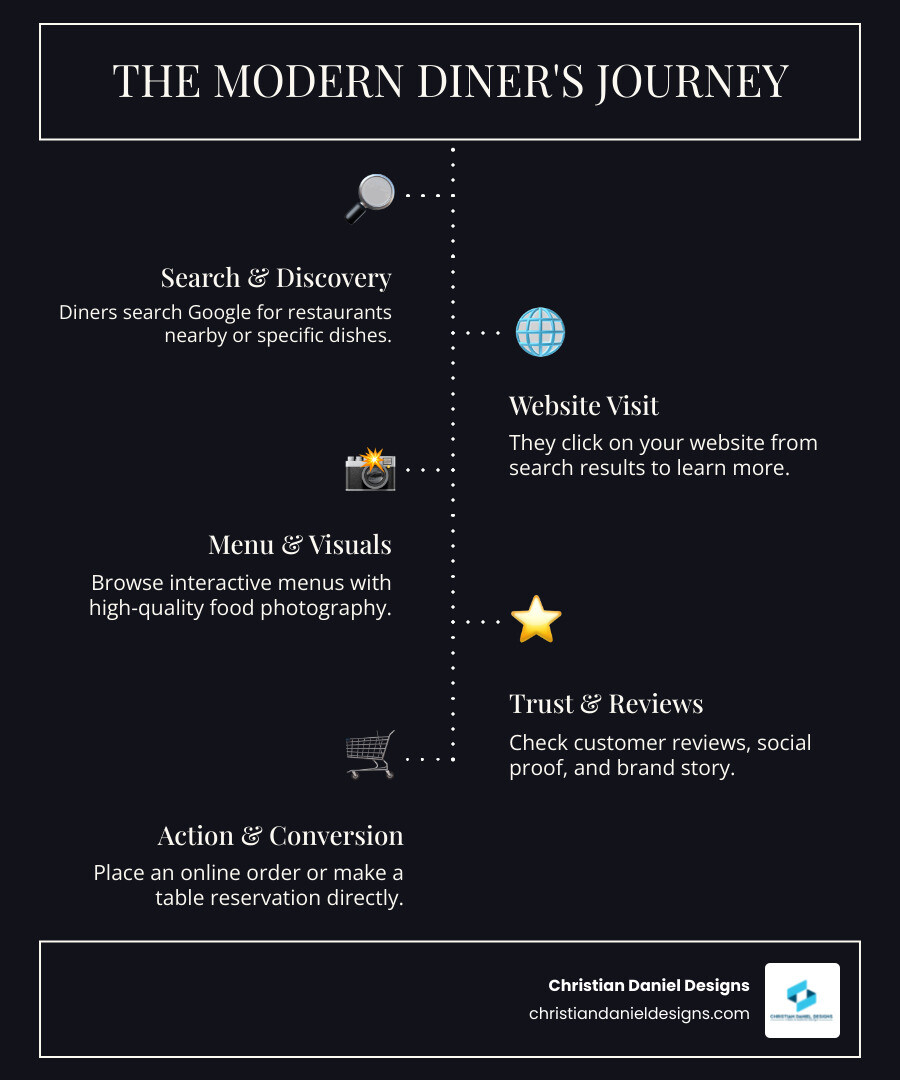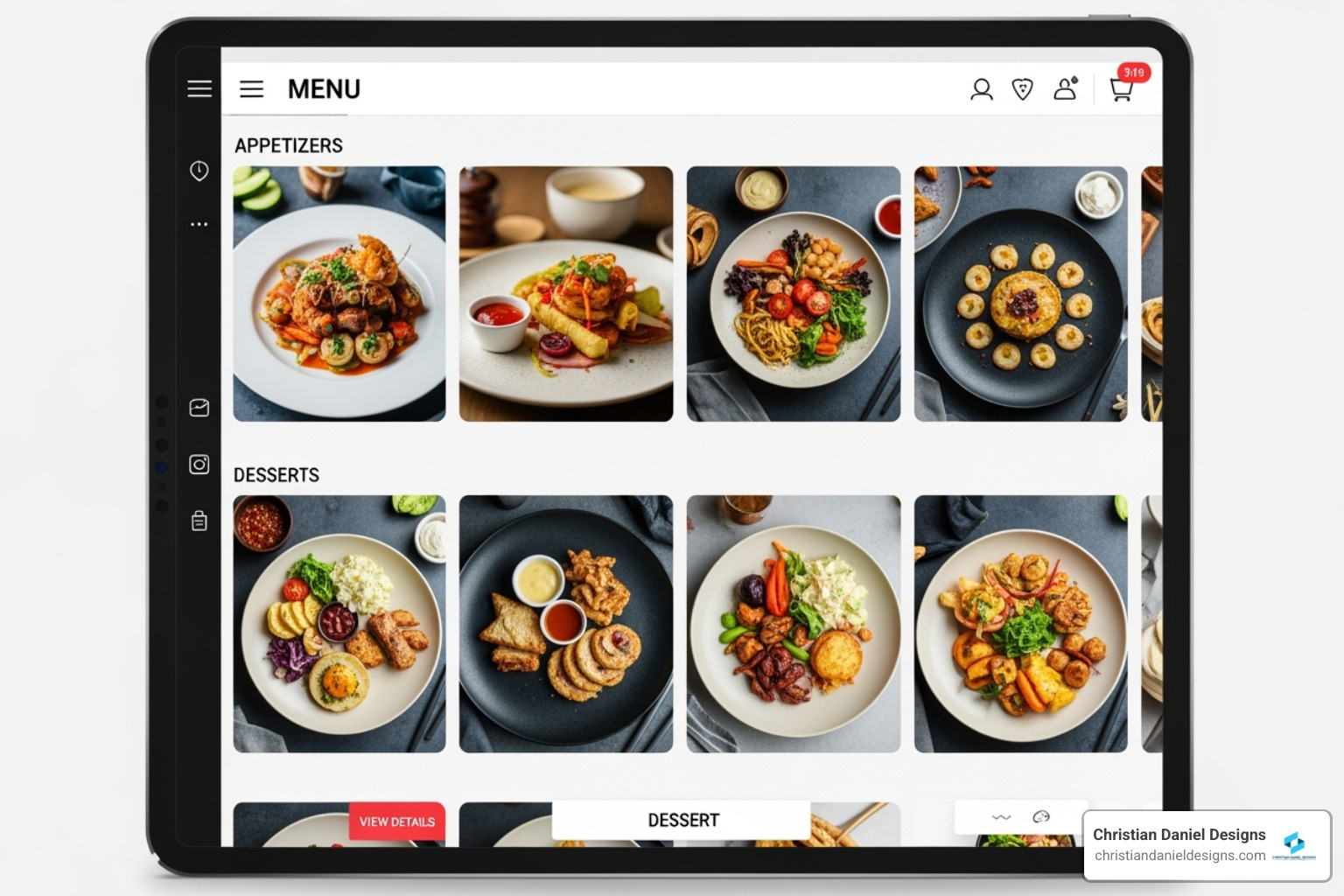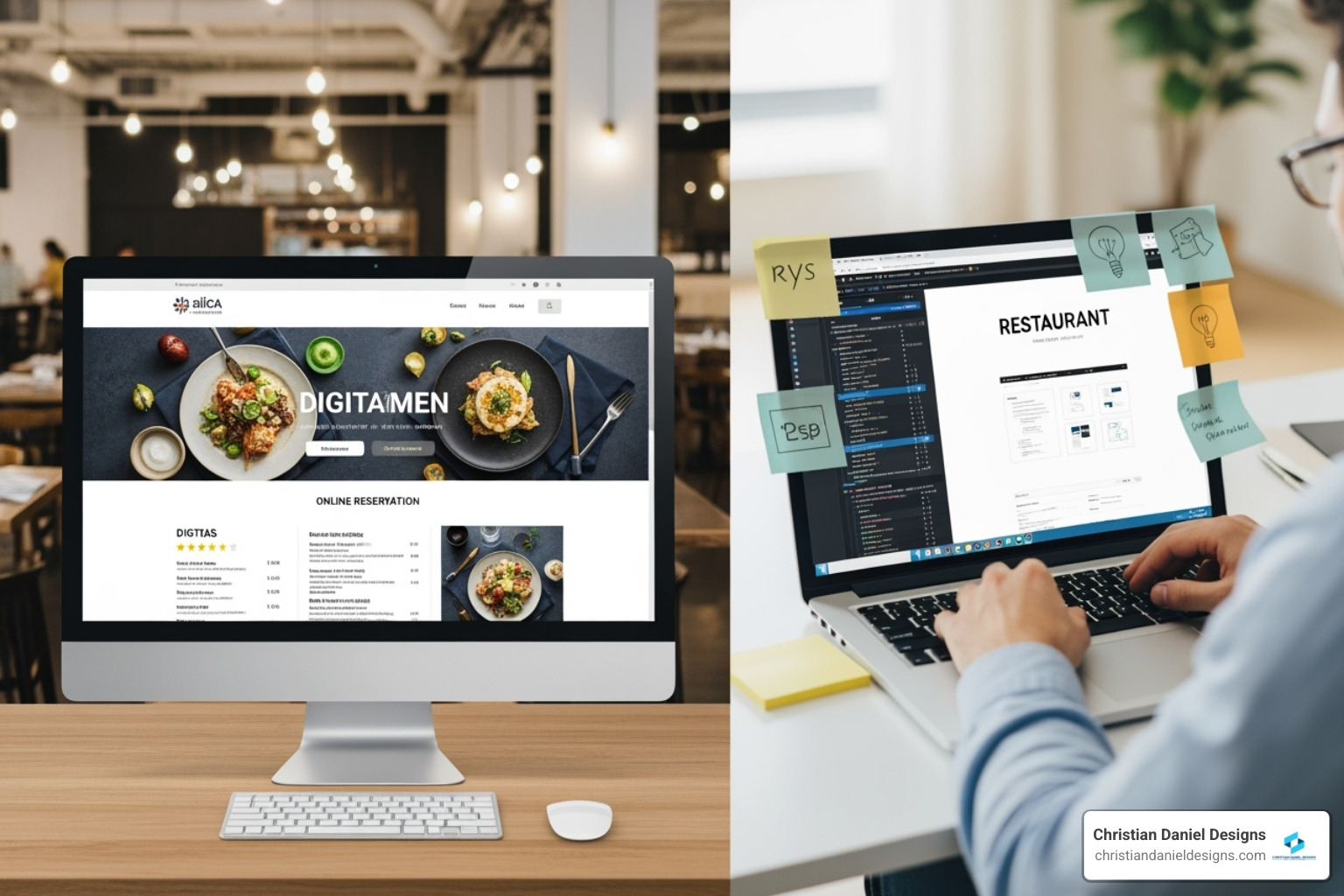Why Restaurant Web Development Matters More Than Ever
Restaurant web development creates a professional online presence to attract diners, drive orders, and build your brand. Key elements include:
- Mobile-first design – Your site must work perfectly on smartphones
- Interactive menu – No PDFs; use browsable menus with photos
- Online ordering – Direct ordering beats third-party platforms
- Reservation system – Let customers book tables 24/7
- Fast loading speeds – 53% of users leave slow sites
- Local SEO – Appear in Google searches for “restaurants near me”
- High-quality photos – 61% of guests say menu photos are critical
Statistics show that 77% of diners check your website before visiting, and 91% visit before ordering takeout. Your website is no longer a digital brochure; it’s your most powerful sales tool.
When someone searches for food, your website is their first impression. A slow, outdated, or difficult site means a lost customer. A professional website, however, works as a 24/7 salesperson, showcasing your menu, enabling instant orders, building trust with reviews, and fostering loyalty.
Online ordering alone has grown 300% since 2020. This isn’t a trend—it’s the new reality.
I’m Christian Daniel. With over two decades of experience in restaurant web development for brands like The Plaza Hotel and Park Hyatt Chicago, I’ve learned what separates a high-converting website from one that fails: understanding modern diner behavior.
Let me walk you through what makes a restaurant website work in 2025.

Quick Restaurant web development definitions:
Why a Professional Website is Your Restaurant’s Most Valuable Asset
Your website is your hardest-working team member, operating 24/7. After 20+ years in restaurant web development, I know a professional website is your most powerful tool for attracting and retaining customers. The data is clear: 70% of US customers search for local restaurants online. If you’re not showing up with a polished presence, you’re turning away hungry customers.
Beyond being findable, your website showcases your brand story in a way no social media post can. It’s where you explain why your restaurant exists and what makes your chef passionate. I’ve seen restaurants transform their business by telling their story online. An emotional connection builds relationships and loyalty before a guest even tastes your food. For more on crafting that identity, see my thoughts on Hospitality Branding Solutions.
The Power of a First Impression
Your website creates a gut reaction in about three seconds. User experience (UX) is the difference between a customer who orders and one who clicks away to a competitor. A slow, confusing, or outdated site damages your brand perception instantly.
The statistics are sobering: 69% of guests say a poorly designed website makes them less likely to order. That’s nearly seven out of ten potential customers lost. A professional website builds immediate trust, telling visitors you care about details. I’ve watched restaurants turn their online reputation around simply by investing in clear navigation and intuitive design.
To learn what separates great hospitality websites from mediocre ones, read my guide on Characteristics of a Good Hospitality Website Design.
Driving Revenue and Building Loyalty
This is where your website becomes a profit engine. Online ordering has grown 300% since 2020, and 75% of guests want to order online. Direct online ordering through your site lets you avoid hefty third-party commissions, putting more profit back in your pocket.
A built-in reservation system means you never miss a booking. But here’s the key: 87% of guests say they’re more likely to reorder from a restaurant with a great online ordering experience. It’s about creating a process so smooth that customers enjoy ordering from you.
Your website is also home to special offers and loyalty programs. You can gather customer data (with permission) to send targeted promotions, like birthday discounts. For restaurants ready to expand, platforms I discuss in Shopify Restaurant Websites can open new revenue streams like merchandise or meal kits.
The Core of Restaurant Web Development: Essential Features and Branding
My philosophy for restaurant web development is simple: your website should feel like walking into your restaurant—welcoming, easy to steer, and reflective of your unique character.

Let me be blunt: if your menu is a PDF, you’re losing customers. An interactive online menu is what your customers want. In fact, 80% of guests visit your site to see your menu, and 84% look at photos before ordering.
Your website must work beautifully on phones first. Beyond an interactive menu, you need high-quality photography, a seamless online ordering system, and integrated reservation capabilities. Your contact information (name, address, phone) must be clear on every page. For inspiration, I’ve created a Best Restaurant Websites Guide 2025 that showcases excellence in practice.
Must-Have Functional Features
These features are no longer nice-to-haves; they are the baseline for a successful restaurant website.
- Online ordering is your revenue engine. It must be fast and intuitive. I’ve seen restaurants lose thousands from a clunky checkout process.
- Reservation systems free up your staff by allowing customers to book a table at any hour.
- Gift card sales are great for cash flow and attracting new customers who may bring friends and spend more.
- An event calendar keeps regulars engaged with wine tastings, chef’s dinners, or live music.
- A simple contact form provides an easy channel for inquiries and feedback.
For a deeper dive, my Restaurants Website Design Guide walks through each feature.
Showcasing Your Brand and Menu
This is the fun part of restaurant web development—where I help you tell your story. Every restaurant has a unique story. Whether it’s your grandmother’s recipes or a commitment to local farmers, your website is the place to share it. This unique selling proposition (USP) is what turns browsers into loyal customers.
High-quality food photography is not optional. When 61% of guests say menu photos are a critical feature, you can’t afford amateur shots. I’ve seen restaurants double online orders just by upgrading their photography.
Video content takes this further, creating an emotional connection by showing your chef in action or the buzz of your dining room. Your menu should be interactive, allowing customers to click dishes for details and allergen info. Finally, showcase your atmosphere with beautiful images of your dining room, bar, and patio to help guests envision themselves there.
Your homepage is critical. I’ve compiled strategies in my Restaurant Homepage Design Tips to help you nail that first impression.
The Development Path: Platforms, Professionals, and Performance
Building your restaurant’s website involves key choices: template or custom, DIY or professional. These decisions will define your site’s performance and ability to attract customers. With over 20 years of experience, I can guide you through what works best. The principles I discuss for Custom Hotel Websites apply just as much here.
DIY vs. Professional Restaurant Web Development: A Cost-Benefit Analysis
I understand that budgets are tight, and DIY builders seem tempting. However, I’ve often seen owners waste weeks on templates only to end up with a frustrating, underperforming site. The real cost of DIY is your time, the lack of expertise in SEO and mobile optimization, and customization limits that block crucial features.
When I build a site, I bring two decades of specialized knowledge. I know how to integrate your POS, optimize your menu for mobile, and structure your site for Google. The long-term ROI of professional development is clear: a faster site that converts better and requires fewer fixes. Yes, it costs more upfront, but my ongoing support means you’re never stuck when something breaks on a busy Friday night. For more on this, see my guide on Web Design for Hospitality.
Choosing Your Platform: Website Builders vs. Custom Code
Choosing a platform is a huge decision. I work primarily with WordPress, but here’s an honest breakdown of your options:
| Feature | WordPress | Squarespace | Wix | Custom Development |
|---|---|---|---|---|
| Cost | Low initial (free software), variable for plugins/themes/hosting; $4-$45/month for managed hosting. | $16-$40/month (all-inclusive) | Free (with ads) to $17-$159/month (premium plans) | $5,000-$70,000+ (one-time, then maintenance) |
| Customization | High (themes, plugins, custom code) | Moderate (template-based, some CSS) | Moderate (drag-and-drop, app market) | Unlimited |
| SEO | Excellent (with proper plugins & optimization) | Good (built-in features, but can be limited) | Good (built-in features, can be limited) | Excellent (built for purpose) |
| Ease of Use | Moderate (learning curve for full power) | High (intuitive drag-and-drop) | Very High (drag-and-drop) | Varies (requires developer for changes) |
| Scalability | High (can handle complex features) | Moderate (good for small to mid-sized) | Moderate (good for small to mid-sized) | Very High (built to scale) |
WordPress is my preferred platform for restaurants. It offers incredible flexibility and scalability without the high cost of fully custom development. Squarespace and Wix are easy to use for simple sites but have limitations. Custom development offers the best performance and unlimited possibilities, making it ideal for high-end or multi-location brands. A tool like Find Your Builder can help, but a direct conversation with me will provide clearer direction.
Technical Excellence: Speed, Mobile, and Accessibility
Technical excellence is what separates a successful website from a failing one. It’s not glamorous, but it’s critical.
Website speed is non-negotiable. With 53% of users abandoning a site that takes more than 3 seconds to load, I ensure every site I build is fast, using tools like PageSpeed Insights. Google also rewards fast sites with better local search rankings.
Mobile optimization is where many sites fail. Most diners browse on their phones, so a poor mobile experience is a disaster. I build every site using responsive web design principles, ensuring the layout automatically adapts to any screen. It’s about rethinking information for a small screen, a topic I cover in my Responsive Restaurant Websites Ultimate Guide.
ADA compliance ensures your website is accessible to people with disabilities. Beyond being a legal requirement in the US, it’s the right thing to do. I build accessibility into every site from the start, which also improves the experience for all users.
Maximizing Your Online Presence: SEO, Engagement, and Future Trends
A great website is only effective if customers can find it. This is where restaurant web development extends into search engine optimization (SEO), customer engagement, and future-proofing your digital presence.

Most people find restaurants by searching “sushi near me” on their phones. If you don’t appear in those first few results, you’re invisible. Local SEO is critical for appearing in the Google Map Pack—the top three listings with star ratings. This requires an optimized Google Business Profile, positive reviews, and location-specific website content.
Don’t underestimate social proof: 74% of guests look for reviews on a restaurant’s website before making a decision. Showcasing this content builds trust. For a full guide, see my Ultimate Hospitality Web Design Guide.
Optimizing for Search Engines (SEO)
SEO is a long-term investment, not a magic switch. It requires patience, but the payoff is a steady stream of new customers without ad spend.
My approach begins with keyword research to understand what customers are actually searching for, from specific cuisines to dietary needs. I then focus on on-page SEO: crafting keyword-rich content, writing clear headlines, and optimizing images. A solid content strategy, like a blog with chef interviews or news about local sourcing, gives search engines more reasons to rank your site.
Link building from reputable local sites establishes your authority. Finally, submitting an XML sitemap via Google Search Console gives search engines a roadmap to your pages. Be patient; it takes time to improve your rankings. Significant results often take 6 to 12 months of consistent effort.
The Future of Restaurant Web Development: Emerging Trends
The digital dining landscape is always evolving. Here’s what I’m watching on the horizon.
- AI integration is becoming a reality. AI-powered chatbots can offer 24/7 customer service, while other tools can help personalize menu recommendations or generate content.
- Progressive Web Apps (PWAs) deliver a fast, reliable, app-like experience directly in a web browser, no download required. This reduces friction and encourages repeat use.
- Voice search optimization is increasingly important. Content needs to be structured to answer natural, conversational questions people ask their smart speakers, like “Where can I get authentic carbonara near me?”
- Hyper-personalization is the next frontier. Using customer data responsibly, you can offer custom promotions or menu suggestions, creating deeper connections and fostering loyalty.
These trends in Hospitality Website Development are practical tools to help your restaurant stand out.
Budgeting and Avoiding Common Pitfalls
Understanding the costs and common mistakes in restaurant web development can save you significant time and money.

How much does a restaurant website cost?
The cost of a restaurant website varies widely, from $500 for a basic template to over $10,000 for a custom build. A simple site with basic info typically falls in the $500-$5,000 range. For more robust features like online ordering, reservation systems, or multi-location management, expect to invest $5,000 to $50,000 or more for custom work.
Ongoing costs include your domain name (~$10-$20/year) and hosting (~$5-$30/month). Platform costs vary: WordPress software is free, but you pay for themes, plugins, and hosting, while builders like Squarespace and Wix have monthly fees. Don’t forget to budget for professional content creation (photography, copywriting) and maintenance ($200-$500+ annually) to keep your site secure and updated.
How long does it take to build a restaurant website?
The timeline depends on complexity. A simple, template-based site can be live in 2-4 weeks. A custom-designed website with advanced features takes 2-3 months on average. This allows for proper design, development, testing, and revisions. The client feedback loop is also a major factor; prompt feedback and content delivery keep the project on schedule.
Can I integrate my POS and third-party delivery services?
Yes, and I highly recommend it. POS integration with systems like Toast, Square, or Clover creates a seamless workflow, sending online orders directly to your kitchen. This is done via API integration, which allows different software to communicate in real-time, reducing errors and freeing up staff.
Regarding third-party delivery services like DoorDash or Uber Eats, I always advise prioritizing direct online ordering to avoid high commissions. You keep more revenue, own the customer data, and control the experience. You can still link to third-party profiles, but make your direct system the star of the show.
Finally, avoid these common mistakes I see all too often: PDF menus, no mobile optimization, poor photos, hidden contact info, neglecting SEO, and outdated information. Any of these can destroy trust and drive customers away.
Let’s Build Your Digital Dining Room
This guide has covered the essentials of restaurant web development, from key features to the technical details that ensure performance. The truth is, a professional website is one of the most valuable investments you can make in your restaurant’s future.
A great website attracts new customers, builds loyalty through effortless ordering and reservations, and tells your unique story. Most importantly, it works around the clock, bringing in business while you focus on what you do best: creating exceptional dining experiences.
I’ve spent over 20 years designing websites and producing video content for hospitality brands, from The Plaza Hotel to Park Hyatt Chicago. My approach combines award-winning design with results-driven solutions, with direct client collaboration at the heart of every project.
Your website should be an extension of your restaurant’s personality. Whether you’re a cozy bistro or an upscale establishment, your digital dining room deserves the same care that goes into every dish.
I’m based in NYC and would love to hear about your vision and discuss your project. I’ll build you a website that not only looks beautiful but drives real results—more reservations, more orders, and more loyal customers.